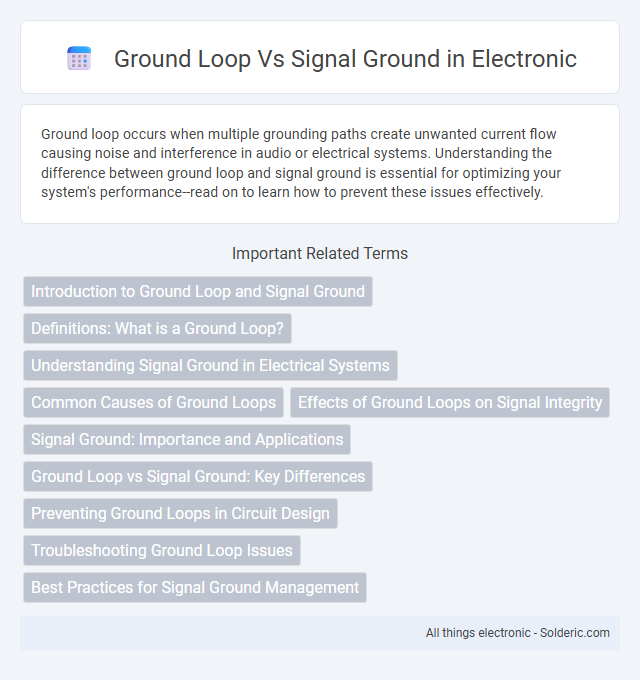Ground loop occurs when multiple grounding paths create unwanted current flow causing noise and interference in audio or electrical systems. Understanding the difference between ground loop and signal ground is essential for optimizing your system's performance--read on to learn how to prevent these issues effectively.
Comparison Table
| Aspect | Ground Loop | Signal Ground |
|---|---|---|
| Definition | Unwanted current path causing noise interference in audio/electronic systems. | Reference point in an electrical circuit for signal integrity and stability. |
| Cause | Multiple grounding paths creating a loop susceptible to electromagnetic interference. | Deliberate connection used as a common return path for signals. |
| Effect | Induces hum, noise, and distortion in signals. | Maintains stable signal reference, reduces noise. |
| Example | Audio equipment humming due to multiple earth grounds. | PCB ground plane used as reference in analog/digital circuits. |
| Solution | Use ground loop isolators, star grounding, or single-point grounding. | Proper PCB design and grounding strategy. |
Introduction to Ground Loop and Signal Ground
Ground loop occurs when multiple ground paths create unwanted current flow, causing interference and noise in audio or electronic systems. Signal ground serves as the reference point for voltage signals, maintaining circuit stability and reducing noise by providing a single, consistent grounding path. Understanding the distinction helps You minimize electrical interference and ensure optimal system performance.
Definitions: What is a Ground Loop?
A ground loop occurs when there are multiple grounding paths forming a closed loop, causing unwanted current flow and interference in audio or electrical systems. Signal ground refers to a common reference point in a circuit that stabilizes voltage levels and reduces noise without creating circulation paths. Understanding the difference between these helps prevent hum and noise in sensitive electronic equipment.
Understanding Signal Ground in Electrical Systems
Signal ground in electrical systems serves as a reference point for voltage measurements and ensures proper operation of circuits by providing a common return path for signals. Unlike ground loops, which occur when multiple grounding paths create unwanted current flow and interference, signal ground is designed to maintain signal integrity and reduce noise. Understanding the distinction helps you minimize electromagnetic interference and achieve reliable performance in sensitive electronic equipment.
Common Causes of Ground Loops
Ground loops commonly arise from multiple grounding points at different potentials within an electrical system, causing unwanted current flow and interference. Improper wiring practices such as parallel connections between signal ground and earth ground can exacerbate noise issues in audio and data transmission systems. Differences in ground reference levels, often due to long cable runs or interconnected equipment, increase susceptibility to hum and signal distortion.
Effects of Ground Loops on Signal Integrity
Ground loops occur when multiple grounding paths create unintended current flow, introducing noise and hum into the signal ground, which degrades signal integrity. This interference can cause distortion, reduced signal-to-noise ratio, and errors in sensitive electronic systems. Understanding how ground loops affect your signal ground is crucial for maintaining accurate and reliable data transmission.
Signal Ground: Importance and Applications
Signal ground is crucial in electronic circuits for maintaining a common reference point, ensuring accurate voltage measurements and reducing noise interference. It stabilizes sensitive analog and digital signals by minimizing voltage fluctuations caused by current flow in the grounding system. Applications of signal ground include audio equipment, communication devices, and precision measurement instruments where clean and stable signals are essential for optimal performance.
Ground Loop vs Signal Ground: Key Differences
Ground loop occurs when multiple ground paths create unwanted current flow, causing noise and interference in audio and electronic systems. Signal ground serves as a clean reference point for circuits, ensuring stable voltage levels and reducing electromagnetic interference. Understanding the key difference helps in designing systems that minimize noise by properly managing grounding configurations.
Preventing Ground Loops in Circuit Design
Preventing ground loops in circuit design requires careful differentiation between a ground loop and a signal ground, where a ground loop refers to unintended current paths causing interference, while a signal ground serves as a reference point for circuits. You can minimize ground loop issues by ensuring a single, well-defined ground path and avoiding multiple ground connections that create loops. Proper grounding techniques, such as star grounding or isolated grounds, help maintain signal integrity and reduce noise in your electronic systems.
Troubleshooting Ground Loop Issues
Troubleshooting ground loop issues requires identifying unwanted current paths caused by multiple grounding points creating noise interference in audio or video systems. Using a single-point grounding scheme and employing isolation transformers or ground loop isolators helps eliminate hum and buzz caused by differences in ground potential. Verifying continuity and proper bonding between signal ground and chassis ground minimizes interference and improves overall system performance.
Best Practices for Signal Ground Management
Effective signal ground management requires careful separation of ground loops to minimize electromagnetic interference and noise in electronic systems. Implementing a single-point ground or star grounding technique ensures that all signal grounds converge at one common reference, eliminating unwanted current paths that cause ground loops. You should also use low-impedance connections and proper shielding to maintain signal integrity and reduce ground-related issues.
Ground loop vs Signal ground Infographic

 solderic.com
solderic.com